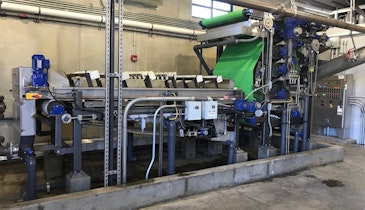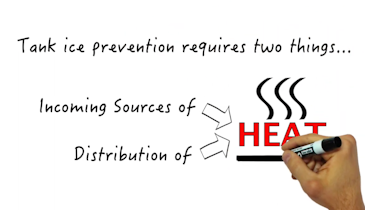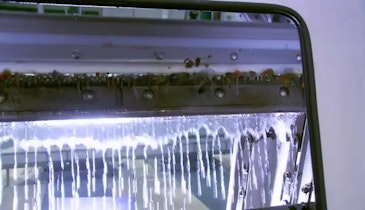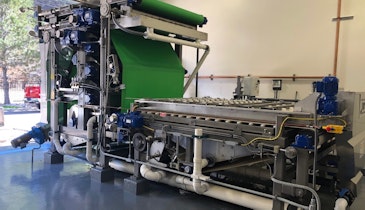Interested in Dewatering/Biosolids?
Get Dewatering/Biosolids articles, news and videos right in your inbox! Sign up now.
Dewatering/Biosolids + Get AlertsThe city of Larned, Kansas, wastewater treatment plant increased efficiencies in multiple areas by replacing its belt press with Prime Solution’s Rotary Fan Press.
Plant challenges:
- Outdated belt press required repair and continuous maintenance
- Belt press required constant monitoring and cleanup, exhausting limited manpower
- New equipment required a retrofit into a small space
- Belt press had a capture rate of only 60-70%
Also known as the City of Larned Water Recycling Center, the plant was in desperate need of a treatment operation update, specifically the mechanical dewatering equipment. When the new plant superintendent, Dale Vanderhoof, took over, he was tasked with turning the facility around and making it a functional plant that was not discharging what they called “blackwater” into the Arkansas river. Vanderhoof is a Class IV Operator and wastewater instructor and assists treatment operations. Under his supervision, the city has received awards over the past several years for “Outstanding Plant Performance.”
Outdated belt press required continuous monitoring and maintenance
As Vanderhoof assessed the situation, his first consideration was updating the old and dilapidated belt press. He knew with the current belt press they were facing not only purchasing parts to get it up and running again, but also had water and sludge spraying all over when in operation. The mess was unacceptable. One person had to always sit by the press and babysit it while it was operating.
Larned reviews multiple dewatering technologies for better efficiencies
After determining the cost to upgrade the current belt press, it was obvious that newer technology would provide the best return on investment. Multiple technologies were reviewed, and after a comparison of centrifuges, screw presses and the Rotary Fan Press, the facility elected to move forward with the Rotary Fan Press.
Dale VanderhoofI was not very familiar with the Rotary Fan Press technology, but after looking at the advantages I knew we needed to find out more information. We wanted modern technology that was made in the U.S.A., and this seemed to be a great fit.”
No mess and an unattended overnight pilot sealed the decision
From the minute the pilot started, Vanderhoof and his team were excited about the technology. Not only was the cake much dryer, and the filtrate much cleaner, but the machine was quiet, and there was no mess. The capture rate with the Rotary Fan Press is 95%. The biggest test for Vanderhoof was if the machine would run unattended overnight. He wanted his team to be able to walk away from the machine during the day and focus on other duties, and have it run overnight without being monitored on site, to increase their processing capacity. When this was proven out overnight during the pilot, that sealed the deal.
The Rotary Fan Press requires minimal maintenance and has only one wear part, a brass scraper to keep the filtration elements clean, which is suggested to be replaced every 5,000 to 10,000 hours, costing approximately $400 per channel. Prime’s Rotary Fan Press is sold with one to six channels, depending on capacity requirements. The slow-moving technology is safer, cleaner and more robust.

Operator attendance on the Rotary Fan Press is minimal. Startup and shutdown take no more than 30 minutes combined, and if there are no upsets in the process, the machine should be able to run continuously until it is shut down manually or by a time assigned to the machine. When shut down, the machine will go through a complete wash cycle (which is controllable by the operator) and shut itself down.
Energy and water usage is low for the Rotary Fan Press
On average the press uses 11.33 kW. Washing of the patented stainless steel filtration elements can be done constantly, or intermittently. It is set to the customers' preference. Washing can occur simultaneously with operation and will not impact the performance of the machine.
Small footprint, big output
The size of the Rotary Fan Press was also important for the city of Larned as they needed it to fit into their current building. They selected the Rotary Fan Press 48 Dual Ship Loose system. Prime Solution worked closely with the customer to make sure the machine not only fit into their building but added several customizations to make the press more visual in areas for monitoring flock and dry cake. “The ability to see through the clear piping allows us to make slight adjustments, and to monitor the operation more closely — as it is happening,” Vanderhoof says. Due to the higher capture rate, they are averaging about 45% more cubic yards of sludge off the Rotary Fan Press than they did with the belt press (16 cubic yards vs. 11 cubic yards). And, even though they send the same amount of sludge to the Rotary Fan Press as they did the belt press, they are able to send it to the Rotary Fan Press at a higher feed rate, so they can process more in less time.
Kevin Cook, Class II operator, said when he first walked into the building, he asked when they were going to start up, only to be told the press was already running. Cook says, “It is so quiet, and we are so pleased with it.”
After almost six months of operation, the City of Larned Water Recycling Center feels like they have a world-class treatment facility. The plant is cleaner. They do not need to spend manpower on cleanups or watching the machine — it ran 72 hours without supervision. The cake solids are visually drier, and the only thing being discharged from this plant is clean water.
“Every time I see the press run; I wonder how such a dry product can be produced by such a small machine. I am amazed,” Vanderhoof says, “and the customer service is top-notch.”






